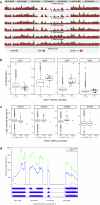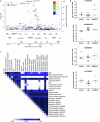Sequence variants influencing the regulation of serum IgG subclass levels
- PMID: 39277589
- PMCID: PMC11401918
- DOI: 10.1038/s41467-024-52470-8
Sequence variants influencing the regulation of serum IgG subclass levels
Abstract
Immunoglobulin G (IgG) is the main isotype of antibody in human blood. IgG consists of four subclasses (IgG1 to IgG4), encoded by separate constant region genes within the Ig heavy chain locus (IGH). Here, we report a genome-wide association study on blood IgG subclass levels. Across 4334 adults and 4571 individuals under 18 years, we discover ten new and identify four known variants at five loci influencing IgG subclass levels. These variants also affect the risk of asthma, autoimmune diseases, and blood traits. Seven variants map to the IGH locus, three to the Fcγ receptor (FCGR) locus, and two to the human leukocyte antigen (HLA) region, affecting the levels of all IgG subclasses. The most significant associations are observed between the G1m (f), G2m(n) and G3m(b*) allotypes, and IgG1, IgG2 and IgG3, respectively. Additionally, we describe selective associations with IgG4 at 16p11.2 (ITGAX) and 17q21.1 (IKZF3, ZPBP2, GSDMB, ORMDL3). Interestingly, the latter coincides with a highly pleiotropic signal where the allele associated with lower IgG4 levels protects against childhood asthma but predisposes to inflammatory bowel disease. Our results provide insight into the regulation of antibody-mediated immunity that can potentially be useful in the development of antibody based therapeutics.
© 2024. The Author(s).
Conflict of interest statement
T.A.O., G.T., L.S., A.J., H.P.E., G.H.H., G.E.T., A.O.A., S.G., K.G., B.V.H., H.H., P.M., G.L.N., S.S., A.S., U.T., P.S., D.F.G., I.J. and K.S. are employees of deCODE Genetics/Amgen, Inc. S.J. is an employee of Alvotech. The remaining authors declare no competing interests.
Figures



References
Publication types
MeSH terms
Substances
Associated data
- Actions
LinkOut - more resources
Full Text Sources
Medical
Research Materials

